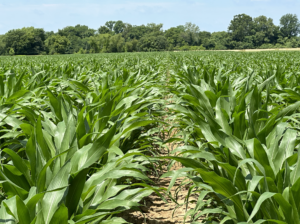In the sports of track and swimming, relay races are often the most exciting events of the meets. You know the concept: a team of usually four athletes races as they follow each other in succession, showcasing performance and precision. For a split moment, while handing a baton or projecting yourself toward the pool as your teammate touches the wall (while your toe remains on the block) both athletes are simultaneously performing. There’s a similar practice in farming called relay cropping.
Just as athletes do on the track or in the pool, relay crops follow each other during the growing season, albeit with a greater overlap. Here, a crop such as rye is planted in the fall and while it actively grows in the spring, a second crop, such as soybeans, is planted into the established rye. Once the rye ripens in the summer – and has risen well above the soybeans – it is harvested. The soybeans continue to grow and get harvested in the fall. Relay cropping has come into vogue with serious soil health advocates. Unlike double cropping – where the first crop is harvested before the second is planted – relay cropping affords the second crop a fuller growing season, and thus, greater yield potential. While soybean yields are slightly lower than those monocropped in early spring, the farmer receives the additional revenue from the rye. Plus, weeds are greatly suppressed by the rye, which can significantly reduce herbicide costs. No-till is typically preferred in these systems, as you conserve moisture by not turning the soil during the dry summer months. From a regen ag perspective, the system has it all: diversity from multiple crop species, continuous surface coverage above the soil surface and continuous biological activity below it. Our friend Mitchell Hora, who farms in Southeast Iowa, is conducting a Huma product trial within a rye/soybeans relay system. He applied Vitol/Breakout and Zap to strips this spring, separately and in combination, as well as check strips. It will be interesting to see how these products impact the yield of both crops.
A welcomed milestone for row crops is canopy closure. This is when the plant leaves from one row extends over and touches those in the row next to it. This closes the open area between the rows and forms a canopy over the exposed dirt. Why’s this a big deal? For starters, it reduces weed competition, as the canopy shades any weeds between the rows. For tall crops like corn, canopy closure usually signals the end of weed competition, especially if the field is clean to that point. Additionally, canopy closure maximizes sunlight. While farmers harvest crops at the end of the season, they harvest sunlight during the season. Thus, they want to see green across their entire field. The goal is to have crops reach canopy as soon as possible. As of Sunday morning (photos below), my corn began to canopy and the rows should be fully shaded early this week. It reached this point at break-neck speed – in just over five weeks. And that is in wide 38-inch rows. Most corn is grown in 30″ rows. We received much needed rain in the Mid-South over the weekend – after going two weeks without any precipitation – and more rain is expected this week.
June is National Dairy Month. Dairy cows will produce over six gallons of milk per day and 350,000 glasses of milk over their lifetime. And they have huge appetites, consuming over 100 pounds of rations while drinking a bathtub full of water every day. These days most cows are milked 2-3 times per day in on-farm dairy parlors using machines, and the milk is never touched by human hands. And before you ask, yes, I have milked cows by hand and machine. As a kid, I often worked for a neighbor who had dairy cows and later performed the tasks in my college animal husbandry classes. Cows typically produce milk for about ten months, then go dry for about two months before delivering their next calf. The gestation period of a cow is very similar to humans. About 45 days after giving birth, the cows are bred again. Nowadays, about 2/3 of cows are artificially inseminated. There are about 30,000 dairy farms in America. The fastest growing dairy state is Texas, now ranking third in the USA behind California and Wisconsin.
Related Posts

This Week in Ag #62
Last week my wife and I frequented a rather posh coffee shop in Gilbert, AZ. I was wearing my “God Made a Farmer” t-shirt, likely not common attire for such a place. Yet the number of compliments I received about it was astounding. The well-to-do clientele ranged from fancy-iced-coffee-drinking twenty somethings to retired couples. But the tenor

Amazing Results with HUMA GRO® on Cotton Farm
See what Russel said about his cotton farm and the results of applying HUMA GRO® SUPER PHOS™ and BREAKOUT® nutrients to the crop. Or see more videos here.

This Week in Ag #51
Back in the mid-1980s, this then-high school student attended a farmer meeting with dad. One of the speakers was a commodities advisor. He playfully asked the attendees what their target price was for their crops. He further inquired, “How many of you are still holding out for the return of $12 soybeans?” The sheepish looks






